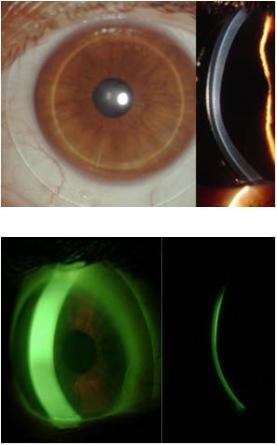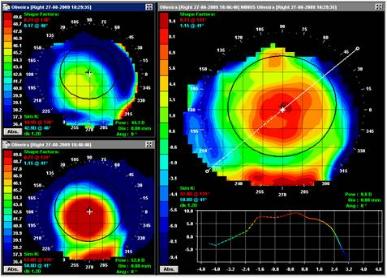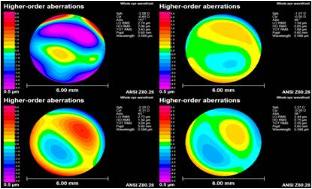
Specialty Soft Lenses for Keratoconus & Visual Quality
Report from the Global Specialty Lens Symposium, Las Vegas (USA) 2010
The goal of this study was to evaluate the performance of a novel thick soft contact lens
made in both conventional hydrogel and silicone hydrogel materials for keratoconic eyes.
Soft-K lenses are produced by Soflex Isralens Ltd (Misgav, Israel). They are produced in
both a conventional hydrogel material (67% water content material from Contamac) and a
silicone hydrogel material (75% material from Contamac). Images below show how the
lens fits on a keratoconic eye, including the tear film layer under high molecular weight
fluorescein observation.
The thickness of these lenses helps to create an effect of regularization on distorted
corneal surfaces as shown in the topography below: the left-bottom picture shows the
topography before and the left-upper picture shows the topography after Soft-k fitting – over
the lens. Early observations indicated that these lenses were effective in improving vision
(Gonzalez-Méijome et al, 2006)*.
In order to evaluate the aim objectively, the visual analysis was expanded to include lower
contrast conditions and whole eye wavefront aberrometry. Researchers found that the
optical quality of the eye improves significantly when keratoconus patients were wearing
these lenses.
The results show that it is possible to significantly improve visual acuity even under lower
contrast conditions.
From a subjective point of view, the lenses were effective in improving best corrected
visual acuity (BCVA) from 0.15 to -0.02 LogMAR units under high contrast conditions
and even from 0.35 to 0.18 LogMAR units under low contrast conditions (10%) binocularly.
These results are objectively supported by the results of higher order aberrations (HOA)
analysis that demonstrated a decrease in HOA Rms, which is statistically significant for
coma-like aberrations that are typically associated with this pathology. The image to the
right in the image above represents the wavefront error without (left)
and with Soft-k (right images).
Report from the Global Specialty Lens Symposium, Las Vegas (USA) 2010
The goal of this study was to evaluate the performance of a novel thick soft contact lens
made in both conventional hydrogel and silicone hydrogel materials for keratoconic eyes.
Soft-K lenses are produced by Soflex Isralens Ltd (Misgav, Israel). They are produced in
both a conventional hydrogel material (67% water content material from Contamac) and a
silicone hydrogel material (75% material from Contamac). Images below show how the
lens fits on a keratoconic eye, including the tear film layer under high molecular weight
fluorescein observation.
The thickness of these lenses helps to create an effect of regularization on distorted
corneal surfaces as shown in the topography below: the left-bottom picture shows the
topography before and the left-upper picture shows the topography after Soft-k fitting – over
the lens. Early observations indicated that these lenses were effective in improving vision
(Gonzalez-Méijome et al, 2006)*.
In order to evaluate the aim objectively, the visual analysis was expanded to include lower
contrast conditions and whole eye wavefront aberrometry. Researchers found that the
optical quality of the eye improves significantly when keratoconus patients were wearing
these lenses.
The results show that it is possible to significantly improve visual acuity even under lower
contrast conditions.
From a subjective point of view, the lenses were effective in improving best corrected
visual acuity (BCVA) from 0.15 to -0.02 LogMAR units under high contrast conditions
and even from 0.35 to 0.18 LogMAR units under low contrast conditions (10%) binocularly.
These results are objectively supported by the results of higher order aberrations (HOA)
analysis that demonstrated a decrease in HOA Rms, which is statistically significant for
coma-like aberrations that are typically associated with this pathology. The image to the
right in the image above represents the wavefront error without (left)
and with Soft-k (right images).



| José Manuel González-Méijome Optometrist PhD |
Dr.José Manuel Gonzalez-Meijome is an Associate Professor at
Universidade do Minho (Braga, Portugal) and has been involved in
optometry and contact lens teaching and research activities for the last ten years.
He is Adjunct Dean of the Physics Department, Director of Masters Degree Program in
Advanced Optometry, Member of the Scientific Council at the School of Sciences,
Associate Editor in Chief of the Journal of Optometry, Chairman of the International
Conference of Optometry-CIOCV and coordinator of the Clinical & Experimental
Optometry Research Lab.
He has authored over 90 papers in scientific journals and has authored more than ten
book chapters or books in the fields of optometry. He also lectures frequently worldwide.
Universidade do Minho (Braga, Portugal) and has been involved in
optometry and contact lens teaching and research activities for the last ten years.
He is Adjunct Dean of the Physics Department, Director of Masters Degree Program in
Advanced Optometry, Member of the Scientific Council at the School of Sciences,
Associate Editor in Chief of the Journal of Optometry, Chairman of the International
Conference of Optometry-CIOCV and coordinator of the Clinical & Experimental
Optometry Research Lab.
He has authored over 90 papers in scientific journals and has authored more than ten
book chapters or books in the fields of optometry. He also lectures frequently worldwide.
| "Although it is not expected nor desirable that these lenses will replace RGP lenses to correct corneal distortions, the high-oxygen transmissibility and low modulus of modern soft materials make them a serious option when a satisfactory RGP fitting is not warranted because of discomfort or corneal mechanical issues" |


